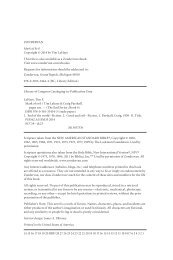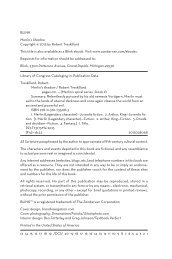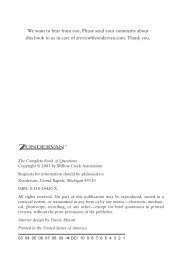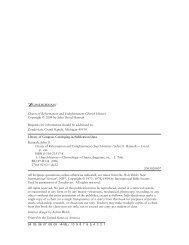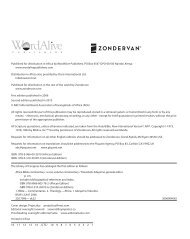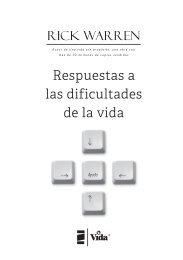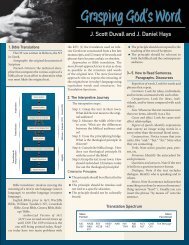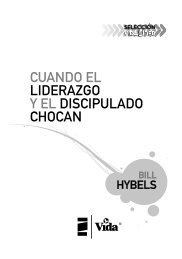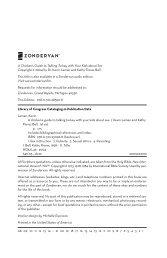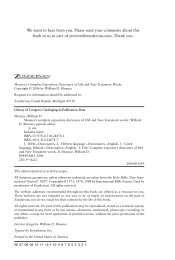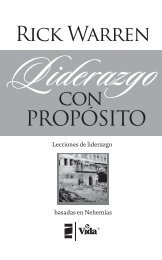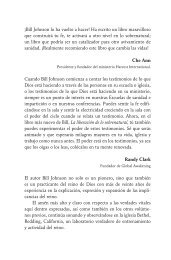Sacred Space: A Hands-On Guide to Creating Multisensory Worship ...
Sacred Space: A Hands-On Guide to Creating Multisensory Worship ...
Sacred Space: A Hands-On Guide to Creating Multisensory Worship ...
- No tags were found...
Create successful ePaper yourself
Turn your PDF publications into a flip-book with our unique Google optimized e-Paper software.
UNDERSTANDING THE LIMITATIONSOF THE “SERMON”Studies have shown that within aweek, an incredibly high percentageof people can’t recall what wastaught in the sermon the week before.Think about it. How much doyou remember from the sermon lastweek? How about two weeks ago?Three weeks ago? I’ve found youcan ask the preachers themselveswhat they taught two weeks before—and even they have a hard time remembering.I’m not saying sermonsaren’t needed, or that they don’thelp people grow. At Vintage FaithChurch, the sermons run 35 <strong>to</strong> 45minutes long each week. Sermonsare important.But let’s be realistic. In terms oflisteners remembering and internalizingsermons—even a week or twoweeks later—we often believe sermonshave greater staying powerthan they actually do.What we desire through experientialworship is <strong>to</strong> enhance the learningand enhance the remembering.It’s important <strong>to</strong> also create ways forstudents <strong>to</strong> be in the Scriptures andlearn outside of the worship service.In youth ministry, perhaps we canbe teaching theology, apologetics,church his<strong>to</strong>ry, and how <strong>to</strong> study theBible as a normal part of what we do.Small groups are another major waywe help students learn and developthe skills of personal Bible study. Bu<strong>to</strong>ur single gathering each week mustbe designed <strong>to</strong> have the maximumimpact on students’ lives. That’s whywe believe paying attention <strong>to</strong> howstudents learn in our main youthgatherings is very important.—Dan KimballWhat we teach about God shapes our attitudes <strong>to</strong>wardGod. However, we need <strong>to</strong> also consider that teachingnonverbally is a valid and necessary (and biblical) way <strong>to</strong>teach as well.We should always be asking ourselves, Is how wepreach based on the Bible, or is it our own particular preference?For example, the Bible never says that we shouldgive three- or four-point sermons. The Bible never sayswe should always end sermons with application points.What it says is <strong>to</strong> watch doctrine and preach with the wisdomand power of the Spirit, not our own wisdom andpower. So there may be many valid ways <strong>to</strong> preach—andwe rather should be asking ourselves, Is our preaching accurateaccording <strong>to</strong> Scripture? and Is our preaching effectiveand changing lives?This book is designed <strong>to</strong> assist you in proclaimingthe truths of Scripture and doing it in new ways <strong>to</strong> moredeeply reach your students.So please understand; we don’t view experiential,multisensory worship as simply a fad. We don’t see this aswatering down the Scriptures. We see this as teachingthe Scriptures in ways that help students learn and rememberthem.Knowing How We Learn Is Crucial<strong>to</strong> Spiritual Growth and How We TeachDid you know that research shows that only 20 percent ofthe world learns through their ears? Thus, if we want theother 80 percent of us (and our students) <strong>to</strong> “get” the s<strong>to</strong>ryof God, then we need <strong>to</strong> teach the Bible in more ways thansimply audi<strong>to</strong>ry (i.e., sermons or talks).Of course this doesn’t just mean simply adding a videoor a slide show <strong>to</strong> your “up front” time. The latter visualsare fine, but they still make the members of your group16



